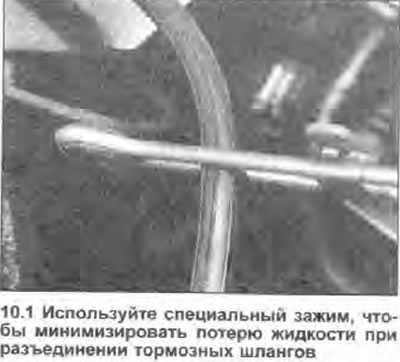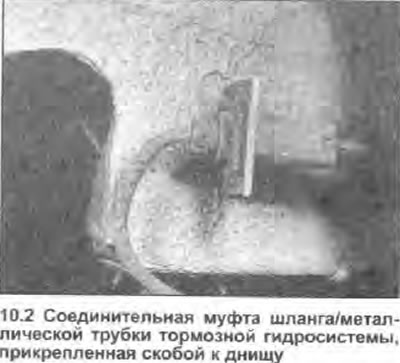Note: Please refer to the note given at the beginning of the Chapter 9.
1. If any tube or hose needs to be replaced, remove the master cylinder feed tank cap and re-tighten it with a piece of polyethylene under the cap (do not damage the level sensor). This will give an airtight seal and prevent liquid from spilling. Alternatively, pinch the hoses with a special clamp (see photo) or plug the metal connectors. Place a rag under the disengaging sleeve to catch the escaping fluid.

2. If it is necessary to detach the hose, unscrew the union nut and remove the spring clip securing the hose to the bracket (see photo).

3. In order to unscrew the connecting nuts, you need a special ring wrench. Alternatively, an appropriately sized wrench can be used, although if the nuts are corroded, there is a great risk of stripping them. In this case, use a self-locking wrench and replace the tube and damaged nuts. Be sure to clean the connector and surrounding area before removing the tube. When removing a component with more than one coupler, sketch the connections before disconnecting them.
4. If the brake pipe is to be replaced, a ready-made pipe of the required length, with connecting nuts and already flared ends, can be purchased from Skoda dealers. It remains only to bend the tube according to the desired profile and install it on the car. It is possible to make a tube yourself, but this requires a very accurate measurement of the original.
5. When installing, do not overtighten the union nuts. There is no need to apply too much force to get a reliable connection. Be sure to replace all sealing washers when installing hoses.
6. Check that the tubes and hoses are routed correctly, without twists or loops, and that they are secured in the appropriate brackets/brackets. After installation, remove the polyethylene from the reservoir neck and bleed the brake hydraulic system as described in Chapter 9. Wash off any spilled fluid and carefully check the system for leaks.
